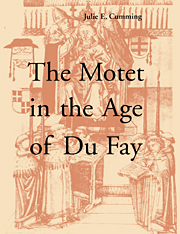Book contents
- Frontmatter
- Contents
- List of tables
- List of musical examples
- Acknowledgments
- Notes to the reader
- Introduction
- Part I Models and methods
- Part II Motets in the early fifteenth century: the case of Bologna Q15
- Part III Motets in the mid-fifteenth century: the case of the Trent Codices
- 8 Motets in the Trent Codices: establishing the boundaries
- 9 English and continental cantilena-style motets
- 10 Motets with a tenor cantus firmus c. 1430–1450
- 11 Freely composed four-voice writing in transition
- 12 The four-voice motet c. 1450–1475
- Conclusion
- Appendix: Widely disseminated motets
- Notes
- Bibliography of books and articles
- Modern editions of music
- Sources and sigla
- Notes on the index of works
- Abbreviations for subgenre identifications
- Index of works
- General index
10 - Motets with a tenor cantus firmus c. 1430–1450
Published online by Cambridge University Press: 22 September 2009
- Frontmatter
- Contents
- List of tables
- List of musical examples
- Acknowledgments
- Notes to the reader
- Introduction
- Part I Models and methods
- Part II Motets in the early fifteenth century: the case of Bologna Q15
- Part III Motets in the mid-fifteenth century: the case of the Trent Codices
- 8 Motets in the Trent Codices: establishing the boundaries
- 9 English and continental cantilena-style motets
- 10 Motets with a tenor cantus firmus c. 1430–1450
- 11 Freely composed four-voice writing in transition
- 12 The four-voice motet c. 1450–1475
- Conclusion
- Appendix: Widely disseminated motets
- Notes
- Bibliography of books and articles
- Modern editions of music
- Sources and sigla
- Notes on the index of works
- Abbreviations for subgenre identifications
- Index of works
- General index
Summary
It was relatively easy to trace the continued evolution of the three-voice cantilena-style motets in chapter 9, since their basic texture stays the same. Things are more complex when we turn to the motet-style motet and developments in four-voice writing in mid-century. The various oppositions and threads of development (English and continental, three- and four-voice, with and without cantus firmus, with and without isorhythm) become tangled. I have chosen to divide the repertory into works with tenor cantus firmus and freely composed works for more than three voices. In this chapter I focus on works of the first group, which trace the strongest line of descent from the great English and French traditions of isorhythmic motet composition. I begin with the motets closest to the Q15 repertory: the four-voice isorhythmic motets in which the top voices are in the same range (Table 10.1). I go on to consider four-voice works in which the upper voices are not in the same range: here I consider both English and continental works (Table 10.2). I turn then to a new non-isorhythmic subgenre, the three-voice tenor motet (Table 10.3). I end with the first major four-voice cantus firmus work without isorhythm, the anonymous English Missa Caput. Although I concentrate on works found in the earlier Trent Codices (87, 92, 93 and 90) and Modena X.1.11, I also include other contemporary pieces, in order to provide a comprehensive look at the surviving examples of these subgenres.
- Type
- Chapter
- Information
- The Motet in the Age of Du Fay , pp. 206 - 227Publisher: Cambridge University PressPrint publication year: 1999



